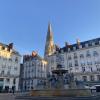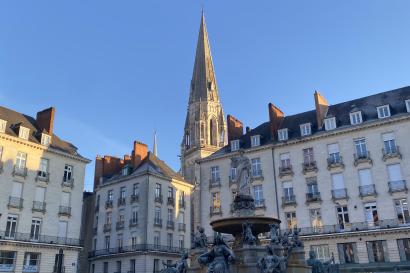Marseille is often considered to be a gritty, unattractive urban center in the south of France that doesn’t have much to offer the average tourist. This makes it the perfect city to spend some time, especially during the low season during your winter break in France, which takes place in February.
It isn’t elegant like Paris, nor quaint and tiny like Avignon. It’s working-class, affordable, and the second largest city in France, not to mention the oldest. Marseille, despite its reputation (which is in the process of changing, visible by the fact that more and more tourists visit every year), is my favorite city in France. From its bustling downtown near the old port, to the magnificent coastal inlets to the East of the city, it has everything you could possibly want in a weeklong trip. I’ll outline the cheapest way to see the amazing things Marseille has to offer.
1. The Vieux Port (Old Port)
The city radiates outwards from this central point, where a large square transforms into an open-air market every morning, offering local wares from baked goods to fish caught that earlier that day. Watching the fishmongers hawk their wares and the local Marseille population buy their dinners for that evening is a destination in and of itself, but the Vieux Port is surrounded by restaurants where you can spend a pretty penny to sit on a patio near the water and enjoy some seafood. I looked at the menus outside these restaurants and then headed just one block away to get some street food that cost around 6 euros. I carried that back to the water and watched people mill around the port filled with the masts of hundreds of sailing ships, all watched over by the Basilica of Notre Dame de la Garde, which surveys the whole city.
From the Vieux Port, you can buy tickets to go on boat tours of the calanques and visit the islands right next to Marseille. One such island houses the famous Château d’If, made famous by Alexandre Dumas’s The Count of Monte Cristo. The château itself is free for European students (which you are) but the ferry costs about $12.80. I suggest packing a lunch, the island is a great place to spread out and read a book or munch on a baguette. The views on the boat ride there and on the island itself are amazing, as you’ll see the whole of Marseille from the sea.
2. Le Panier and Cathédrale La Major
Le Panier is a neighborhood bordering the Vieux Port which is the historical home to the immigrant population of the port city of Marseille. A labyrinth of quaint cobblestone alleys, I wandered around Le Panier several times, getting lost in the old buildings and fun street art that dominates that part of the city. There are bars, restaurants, and shops tucked into this beautiful little corner of the city. On the border of Le Panier and the Vieux Port, several museums like MUCEM, the Mediterranean cultural museum stand near the water which is a great walk at any time of day or night. Also located there is the Fort St. Jean and the unmissable Cathédrale La Major, the oldest Christian church in France. Built in the byzantine style, you’ll feel like you’re in an orthodox Christian country far from France.
3. Les Calanques
Les Calanques is a national park of France, and quite unmissable if you have the physical capacity to hike up steep inclines. Each “Calanque” is an inlet into the beautiful Mediterranean landscape that surround Marseille. I took the bus from the city center all the way out to the Sormiou Calanque, which cost about 4 Euros. Download the MyCalanques app and you can choose a hike that corresponds to your abilities and time constraints. The app will tell you which bus stop to go to for each hike, and you simply plug that into Apple or Google Maps as you prefer. I will admit, it takes time to get there, but it is an absolutely stunning landscape. I was grinning just looking around the path before I even got to the Calanque, which was even more stunning than the trail there.
A few precautions:
- Bring a LOT of water (even in February).
- You might get lost! I did. I had a hard time finding the start of the trail. Don’t worry and don’t panic. The MyCalanques app is great for pinpointing your location and finding nearby trails. Don’t be afraid to ask for help from other hikers!
- Layer up. You’re going to get hot going up, and then cold once the wind from the Mediterranean (the famous Mistral) hits you at the top.
4. Palais Longchamps
If you like art, look no further than Palais Longchamps, which houses some extraordinary paintings, especially of Marseille. The building itself is a beautiful structure decorated by large, ornate fountains and statues of Greek gods looking over the city of Marseille. In the wing opposite the art museum the natural history museum is easily accessible. Both of these museums are free with the French Student ID given to you by IES Nantes at the beginning of the program.
5. Notre-Dame de la Garde
Notre-Dame de la Garde can be accessed by quite easily by bus, but if you want the challenge, you can hoof it all the way up to the highest point in Marseille to take in amazing panoramic views of the city. La Bonne Maman, or the good mother, a statue of Mary holding Baby Jesus, is the highest thing in the city. The chapel inside is almost overwhelmingly ornate, paying homage to the city’s nautical history and standing as a wonderful example of the byzantine church style not found elsewhere in France.
6. Marseille City Museum
For history lovers, the Marseille City Museum is a must see. Also free with your Nantes University student ID, it was a fascinating dive into the history of the oldest city in France starting with the founding of the Greek colony, the ruins of which are visible in the museum’s courtyard. Every era of Marseille is laid out for you to explore, so pick your favorite time period in history and prioritize that so as not to get bogged down in the almost unlimited amount of information and artifacts on display.
Where to stay:
The People Marseille is the hostel I stayed at during my time in the city, which cost about $25 a night (rounding up). Not only is it extremely clean and basically a hotel with several beds per room, but it is centrally located, about a 10-minute walk from the Vieux Port and 15-minute walk from the train station (which also houses the bus to get to and from the airport). I could not have asked for a better price for a better experience.
Several important details:
- You will need a little padlock to lock up your belongings in the locker provided. I bought one in Marseille at a Monoprix fairly cheaply.
- You can also rent a towel for your stay in order to shower! No need to bring one.
What to Eat:
To save money, I went to the grocery store. There is a U City (the city version of a U supermarket) about five minutes from the hostel I used, and I could cobble together two meals for around 14 euros. If you want to eat fancy you totally can, but some fruit, nuts, a baguette and Comté cheese make for a delicious meal. For dinner there are all different types of food but the specialties are Middle Eastern and Italian cuisine (due to their geographic proximity). Cheap food is not hard to find. There’s this little hole in the wall I think is called Kebab Berliner (I’m not sure because they don’t even have a website) one block from the Vieux Port that I ate Tacos (that is, Middle Eastern tacos) two nights in a row for under 7 euros. Take it to go and walk three minutes to one of the benches lining the Vieux Port and eat under the beautiful glow of La Bonne Maman illuminated atop her mountain.
Safety:
Marseille has a bad reputation. It’s known for being the home of the mafia and other such criminal organizations. Most of that happens far from the city center and the Vieux Port, or so I’ve heard. I can only speak on personal experience as a white male and say that Marseille is a perfectly safe city. I wandered around alone at night in Le Panier and along the Vieux Port and did not feel menaced or in danger. The Vieux Port is always populated, lit, and bustling with people, so that is definitely a plus. If at all concerned about safety, I suggest you go with a friend. It’s nice to have someone to do things with and it makes you much safer. In the daytime, there’s nothing to be afraid of at all except pickpockets in the busiest tourist areas like the Vieux Port (just pay attention and don’t put anything in your back pockets).
How to get there:
RyanAir has flights directly from Nantes airport to Marseille, or you can try and figure out a train from Nantes to Paris and then Marseille. The earlier you book, the cheaper the tickets will be, so plan ahead!
Overall, I can’t recommend Marseille enough. It is absolutely my favorite city in France, filled with history and sun 300 days out of the year. From the bustling Vieux Port to the natural beauty of the Calanques, Marseille has everything you could ask for and more. It’s a great break from the rain and cold in Nantes, and it doesn’t have to break the bank.
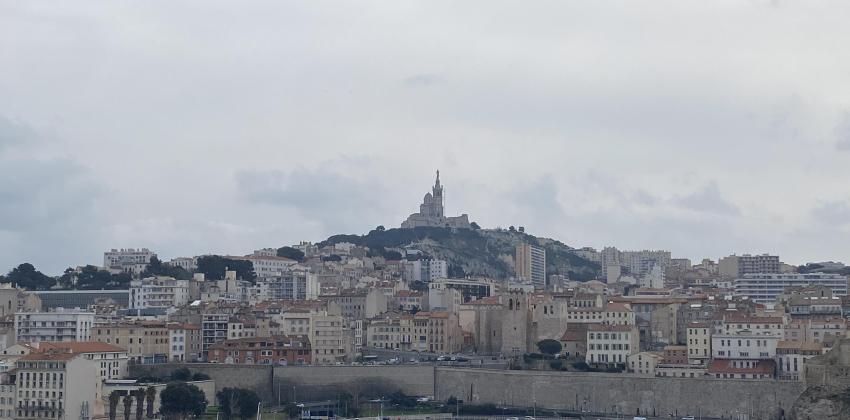
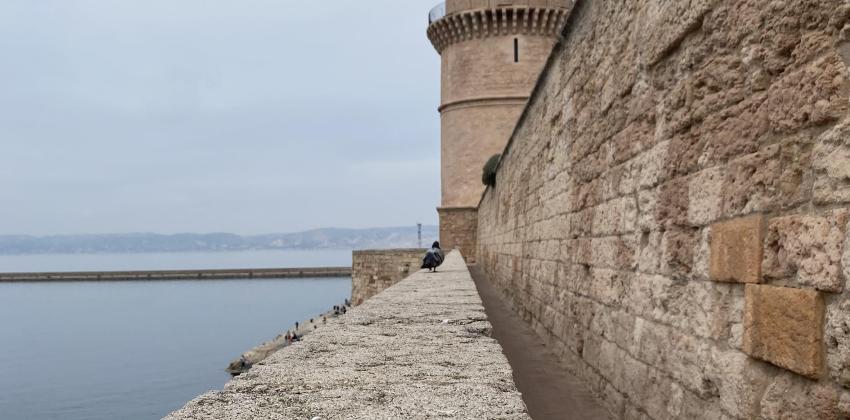
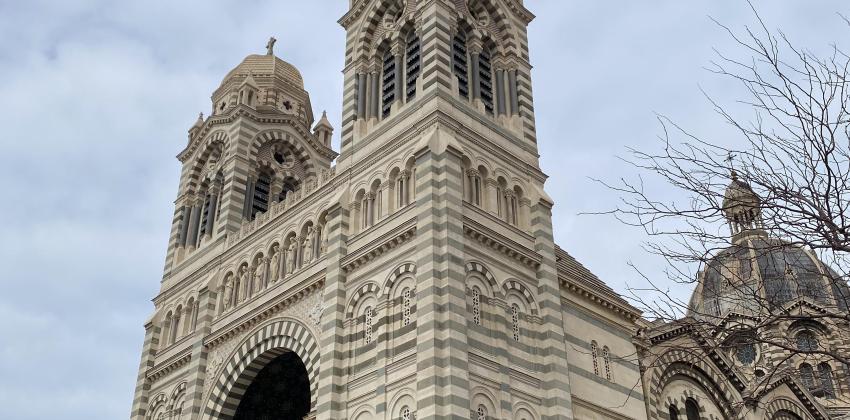

Tyler Schmied
Hi, I'm Tyler! I'm an International Relations and French double major studying abroad in Nantes, France. I love to travel to new places and meet new people! In my spare time, I enjoy reading, hiking, watching movies, and biking.




